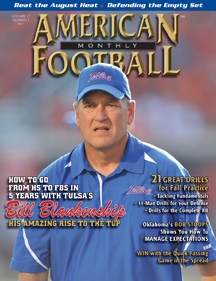Article CategoriesAFM Magazine
|
Quarterback Play: Finding Ways to Complete Passes in Critical Situationsby: Mark NicoletOffensive Graduate Assistant Coach, Drake University © More from this issue Drop and throw, drop and throw, and again, drop and throw. There is no other position in sports that demands such commitment, discipline, and practice. Playing quarterback and more importantly, having the extraordinary opportunity to lead a football team into competition, requires an understanding of not only the position and its necessary skills, but a knowledge of each and every player on offense, and the entire team. How do we train the quarterback to reach a level of play that elevates each player playing beside him? Clearly, when a coach begins to train a quarterback, he does not begin with the 5-step drop. After honing his footwork, body balance, and mechanics of the passing motion, the quarterback will begin to develop his ability to throw from the pocket at the three-step, five-step, and roll out levels. So then at t....The full article can only be seen by subscribers.
|
|
|||||||
| HOME |
MAGAZINE |
SUBSCRIBE | ONLINE COLUMNISTS | COACHING VIDEOS |
Copyright 2025, AmericanFootballMonthly.com
All Rights Reserved





